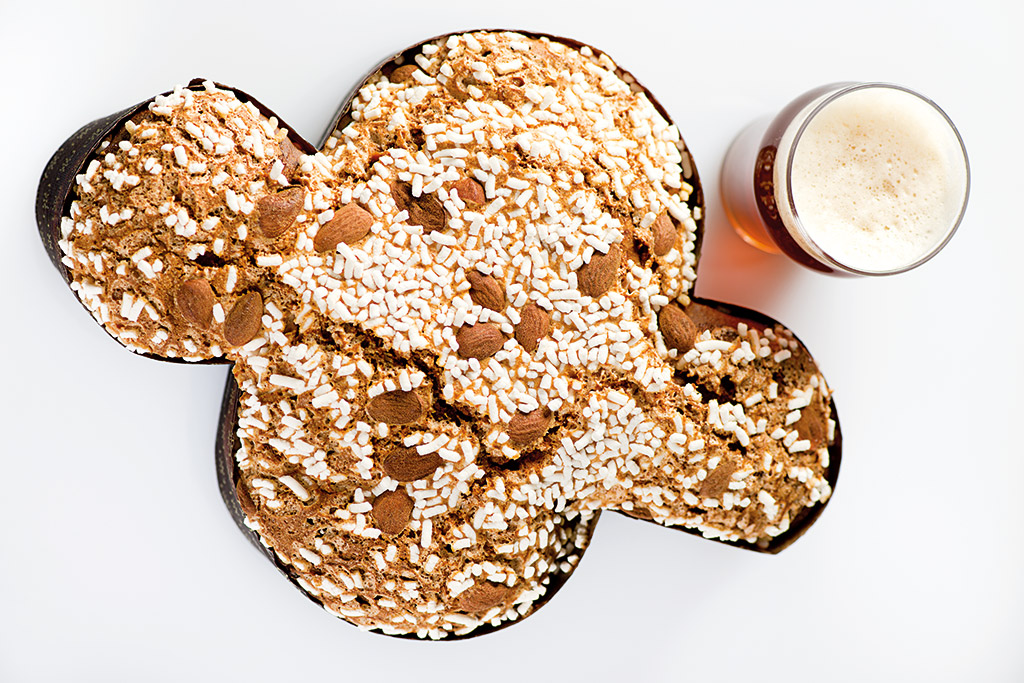
Glaze
750 g Peeled almonds
450 g Whole almonds
300 g Hazelnuts
2,400 g Caster sugar
950 g Egg whites
200 g Potato starch
180 g Corn flour
150 g Seed oil
First dough
1,150 g Starter yeast that is (ready to use after three top-ups in 9 hours)
4,000 g Strong flour W 350 – P/L 0.55
1,200 g Caster sugar
900 g Egg yolks
1,500 g IPA beer (6.3% alcohol)
500 g Water
1,100 g Butter 82%
20 g Compressed yeast
Second dough
330 g IPA beer (6.3% alcohol)
1,100 g Strong flour W 280/300 – P/L 0.50/0.55
1,100 g Caster sugar
70 g Salt
1,500 g Egg yolks
2,000 g Butter 82%
200 g Acacia honey
2 Oranges (rind only)
3 Vanilla pods
3,300 g Candied apricots (cubed)
GLAZE
Crush the almonds, hazelnuts and caster sugar together and add to the mixer (with leaf hook attached) along with the starch and corn flour and knead with the egg whites for a few minutes.
- Make the glaze the day before. It cooks better if it has rested overnight.
- The quantity of oil can be varied; it ensures the glaze doesn’t crack when cooking. Remember that an excessive amount of oil will make the glaze too soft.
FIRST DOUGH
Spread the yeast starter on the bottom of the electric mixer, cover with flour, beer and lukewarm water and knead for 15 minutes at 60 beats per minute or until the dough is formed. Add the sugar and then softened, but not melted, butter. Once absorbed, add the egg yolks and blend to form a smooth, but not overworked, dough. This should not take longer than 25 minutes. Leave the dough to rise for 10-12 hours at 26/27°C. It is very important that the temperature remains below 30°C. The dough is ready when it has tripled in size.
- It is always recommended that you work in a warm environment so the dough doesn’t get too cold and ‘kill’ the yeast.
- It is recommended to use a jar to spy on the development of the yeast.
SECOND DOUGH
Add the flour and beer to the first dough and mix for approximately 15 minutes. Add the sugar in three batches, followed by the honey. Once mixed in, add half the egg yolks and the salt. Mix in the flavourings until absorbed and then the remaining egg yolks and softened, but not melted, butter in two batches. Ensure that the consistency and ‘knit’ of the dough are correct. Add the candied apricots and leave in a warm oven for a few minutes. This should take 40-45 minutes.
- Do not add cold fruit to the mixtures as this will ruin the yeast.
- Use extra-red egg yolks for dough with a brighter yellow colour.
- Excessive use of honey or sugar will make the Colomba very dark and will slow down the rising process.
SHAPING AND COOKING
Remove the dough from the kneader and leave to rest for 30 minutes. Spread the dough out on your work surface. Make small loaves of 950 grams each; place them on a wooden chopping board and leave to rise at 28°C for 35 minutes. Divide each loaf into two pieces; the first should be twice the size of the second. Form two logs and place them in the 1 kg mould in a cross shape. The longer log goes over the shorter one (the shorter forms the wings while the longer log is the central body). Leave to rise for approximately 7 hours at 28/30°C, until the dough is almost at the top of the mould. Glaze and sprinkle with whole almonds and sugar. Cook in a fan oven at 180°C for 55 minutes. Once the Colomba is cooked, remove from the mould and wait 10 minutes before wrapping.
- Use medium-sized almonds for the decoration, which are more aesthetically pleasing and not as sweet.
- Do not use excessive glaze because it will escape when cooked. Excessive glaze will just collect at the edges inside the mould.